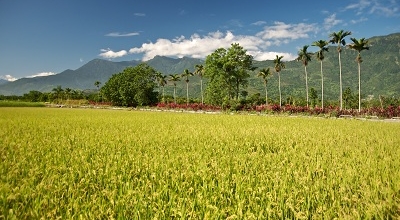Rice is seen as the staple food across almost all Asian countries. But changes to nutrition education, concerns about agricultural demands and a trend towards urbanisation are all pushing a move to less rice on the Asian plate. By Rina Chandran/Reuters.
TAIPEI, 9 July 2018. In Taipei's Ximending district, tourists and locals jostle at restaurants and street stalls to choose their lunch. Steamed and fried dumplings, flat and thin noodles, stuffed pancakes, grills and more are all on offer. Surprisingly, in this Asian foodie haven, one item is conspicuous by its relative absence - rice.
Rice is still grown everywhere in Taiwan - but the amount being consumed is dropping. Courtesy Wikimedia.
With some 60% of the world's population, Asia makes up some 90% of global rice production and consumption. China, India and Indonesia gulp down the lion’s share. But as trends in Taiwan, Japan, South Korea and Hong Kong all show, rice eaters are putting away less and less as societies change. Per capita consumption has fallen about 60% in Hong Kong since 1961, and by almost half in Japan. In South Korea, it has slid more than 40% since 1978 according to data from the United Nations' Food and Agricultural Organization (UNFAO).
"I ate a lot of rice when I was younger but now I eat more vegetables, fish and meat. It's healthier," says local resident Lin Guan-Po. "People [here] are spending more on food, and they want to eat healthy, and rice is not seen as a healthy choice."
Rice is likely to stay the single most important crop in the region for many years, and will remain central to regional diets and a symbol of Asian culture. But it will not be as dominant in coming years as new foods like fish, meat, dairy, fruits and vegetables rise significantly. "[This] is the future for Asia - well-nourished people who can perform better,” says David Dawe, senior economist at UNFAO. “You can’t get that by filling up on rice; you need more fish, meat and the like.”
You might also be interested in...
Once a staple in Taiwan, rice consumption there has fallen overall by more than 65% in 50 years, according to the UNFAO. The country has seen the steepest drop in rice consumption across Asia, but the trend is universally down across the region as "smart crops" and "super foods" take its place. Pushed by urbanisation, rising incomes, climate change and concerns about health and food resources, alternatives such as fruits and vegetables, millet and high protein foods are also rising in popularity.
"It's important that we can grow [rice] varieties that have a higher nutritional value and a smaller environmental footprint," says specialist Prof. Rod Wing, University of Arizona. Malnutrition and climate change are also top concerns for grain biologists and breeders, says Prof. Wing, "Rice feeds the poorest of the poor, and as long as there's overpopulation and poverty, people are going to be eating rice," said Wing, referring to the fact that 60% of the world's hungry are in the Asia Pacific.
Nutrition and income are both issues for rice farmers - Kundhavi Kadiresan, UNFAO Asia. Courtesy UNFAO.
Consequently, UNFAO is also promoting "smart crops" as rice alternatives. Things like aquaculture - farming shrimp, carp and tilapia alongside rice - help rural farmers improve incomes while making fish more cheaply available. "Asian farmers will not get rich growing rice on a small farm," says Kundhavi Kadiresan, of UNFAO Asia.
"[Many] countries are starting to take the issues of undernutrition, micronutrient deficiency and obesity seriously,” she adds. “Sticking to rice means that [important] fruits and vegetables are not as easily available or as affordable as they could be."
In Taiwan, millets were the original staple of indigenous and rural people. They are richer in protein, fibre and micronutrients than rice or wheat, and need less water. They can also grow in saline soil and withstand warmer climate; both crucial factors as temperatures and sea levels rise in South Asia.
In the Philippines, sweet potato, purple yam, jackfruit, and cassava are being seen as rice replacements. Courtesy Sarahlyn Pablo.
Indeed, the Philippines, one of the world's biggest importers of rice, has seen its government considered substitutes such as corn, banana, sweet potato, cassava, taro and adlai - also known as Chinese Pearl Barley.
The Filipino government has flagged a potential problem with rice consumption exacerbating food insecurity, given that “the resources needed for rice production are diminishing incessantly.” Across all its islands, per capita consumption of rice was estimated at almost 115kg a year in 2012. However, in another survey, locals consumed 1kg (67% of daily food requirements) of rice daily with 51% from their own fields and 28% from local retail sellers.
Although irretrievably linked to Asian culture, rice did not become broadly popular there until the Green Revolution of the 1960s, when governments introduced higher yielding seeds and better fertilisers to improve output and feed expanding populations. It filled an urgent need at the time, but that time has passed and many people's tastes are changing.
Once ubiquitous, rice is vanishing from Asian tables. Courtesy Food Network.
Those changes are already evident in mainland China and across other southeast Asian countries, where people are eating a more protein-rich diet with more meat and fish. The move to rice alternatives, fed by concerns about food resource and good diets is gathering momentum.
But although the rice tide is turning, for many consumers like Lin in Taipei rice is still here to stay - just in smaller quantities. "We may eat less of it, but for my family, no meal is complete without rice," he says.



